The “Fruits” and the Future of Centralization in Public Schools
Centralization in public schools through school district consolidation was pitched as a way to save administrative costs in American public schools. Instead, public school administration has mirrored the trend of virtually every other government input: growth. Such centralization has contributed to a decrease in the ability of parents to “vote with their feet” for better and/or more appropriate schools for their children.
From the 1949-50 school year until the 2010-11 school year, the number of American school districts declined by about 84 percent, while the American population increased by just over 100 percent. However, during that same period, the number of school district and administrative staff and school principals and assistant principals increased about three times as fast as the increase in students. “Support staff”—which includes school district administrative support staff, school and library support staff, student support staff, and other support services staff—increased more than five times as fast as the increase in students.
Changes in the Number of K-12 Public School Students, Administrators, Administrative Support Staff, and School Districts in America, 1949-50 to 2010-11
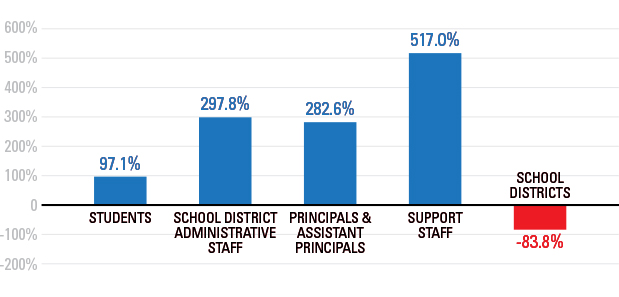
I am not suggesting school district consolidation caused the massive increases in school and district administration and administrative support. But any savings that might accrue from consolidation were dwarfed by the past 60 years’ increased kludgocracy—more federal and state spending and control over “local” public schools, added bureaucracy, and less competition and choice for students and their families.
And administration and administrative support staff weren’t the only personnel increasing rapidly during that period—all public school employment grew at a much higher rate than the increase in public school students.
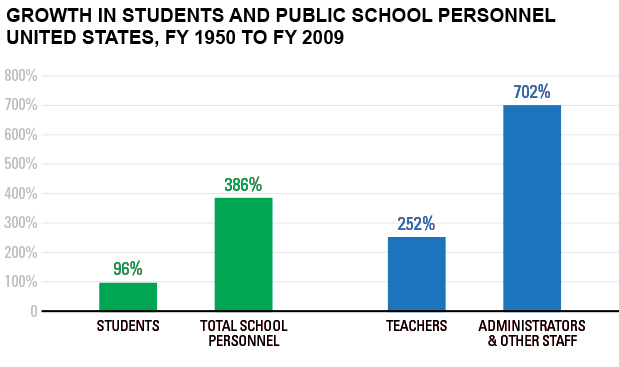
As shown in the chart above, over a 60-year period the number of public school teachers increased more than two-and-a-half times the increase in public school students. The number of administrators and other personnel (all non-lead teachers) increased by more than seven times the increase in students. (All figures are in full-time equivalents.)
Some argue this dramatic increase in public school staffing was warranted because students have more disadvantages than in the past. Actually, the only research on this issue finds that students in recent years are slightly more advantaged relative to 1970. Furthermore, student achievement did not rise during this “staffing surge.”
Is this trend sustainable—or even desirable—and what might it look like 25 years from now?
Based on projections from the National Center for Education Statistics, it seems reasonable to assume the number of public school students will increase by about 15 percent over the next 25 years.With public school employment, let’s suppose the trends moderate significantly. Say, for example, the increase in public school employment is only half of what it has been over the past 60 years (again, as shown in the chart above).
If employment increases curb that significantly over the next 25 years—a very hopeful scenario for taxpayers—the staffing ratios in American public schools would all “improve.” The figures are shown in the chart below.
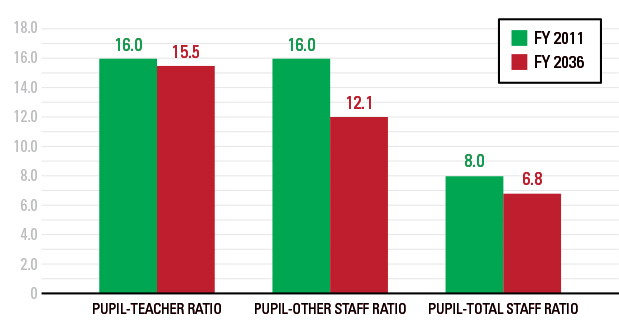
But under that same scenario, by 2036 more than 56 percent of public school employees would not be lead teachers (see the chart below). Again, this is a cautious projection.
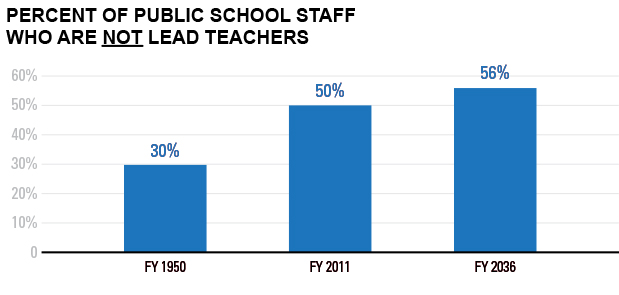
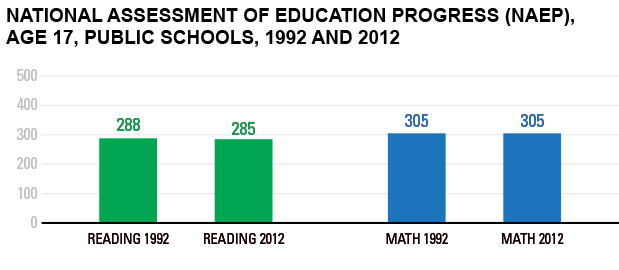
Source: NAEP Long-Term Trend Assessment Results, retrieved from: http://nces.ed.gov/nationsreportcard/ltt/.
If the previous decades-long surge in employment and increase in centralization in American public schools did not lead to increased student achievement, would continuing these trends produce different results? Not likely.
What we do know from these trends is taxpayers are paying a lot more for basically the same results. This is a history not worth repeating.
We can change the system to save taxpayers money while improving student outcomes. The ability for families of all income levels and backgrounds to choose their K-12 schools has been systematically taken away over the past six decades. It’s time we give that power back—parents should be given the choice to send their child to a traditional public school, a public charter school, a private school, a virtual school, or even a home or hybrid school. It’s well past due.
This was the final installment in a three-part series on the increasing centralization of America’s public schools. To read the first post, visit The Decline of “Voting with Your Feet” in American Public School Districts. To read the second, visit Reasons the Public Education System Has Become Increasingly Centralized.




